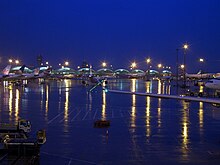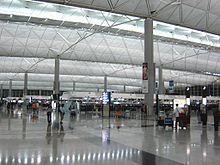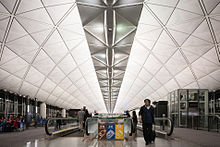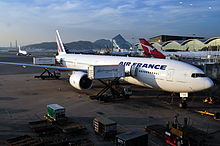Hong Kong International Airport
| Hong Kong International Airport 香港 國際 機場 Chek Lap Kok Airport 赤 鱲 角 機場 |
|
|---|---|

|
|
| Characteristics | |
| ICAO code | VHHH |
| IATA code | HKG |
| Coordinates | |
| Height above MSL | 9 m (30 ft ) |
| Transport links | |
| Distance from the city center | 39 km west of Hong Kong |
| Street | 6 lanes with three lanes each |
| train | Subway |
| Local transport | Buses, taxis and ferries |
| Basic data | |
| opening | July 6, 1998 |
| operator | Airport Authority Hong Kong |
| surface | 1255 ha |
| Terminals | 2 |
| Passengers | 74,672,000 (2018) |
| Air freight | 5,121,000 t (2018) |
| Flight movements |
428,000 (2018) |
| Capacity ( PAX per year) |
50,000,000 |
| Employees | 73,000 (2015) |
| Runways | |
| 07R / 25L | 3800 m × 60 m asphalt |
| 07L / 25R | 3800 m × 60 m asphalt |
| Track 3 under construction since Aug. 2016 |
3800 m |
| website | |
| www.hongkongairport.com | |
The Hong Kong International Airport ( Chinese 香港國際機場 / 香港国际机场 , Pinyin Xiānggǎng Guoji Jīchǎng , Jyutping Hoeng 1 gong 1 Gwok 3 zai 3 Gei 1 coeng 4 ) is the largest airport of Hong Kong and the largest cargo airport in the world. It is also known as Chek Lap Kok Airport ( 赤 鱲 角 機場 / 赤 鱲 角 机场 , Chìlièjiǎo Jīchǎng , Jyutping Cek 3 laap 6 gok 3 Gei 1 coeng 4 ) to distinguish it from its predecessor, Kai Tak , which it replaced in 1998 .
In 2017, it achieved a passenger volume of 72.8 million, making it the second largest airport in the PRC after Beijing (see also Beijing-Daxing ) . Hong Kong Airport is the aviation hub and home airport for Cathay Pacific , Cathay Dragon , Hong Kong Airlines , Hong Kong Express Airways and Air Hong Kong .
history
background
The old and now closed Kai Tak Airport was overcrowded and extremely busy. The residents of Kowloon - especially in the Kowloon City district - complained about the aircraft noise , and it was notorious with the pilots because of the difficult approach to land between mountains (see Checkerboard Hill ) and high-rise buildings. So it was decided to build a new airport.
financing
The British had to leave the former crown colony of Hong Kong by 1997, because after 99 years the leases with the Chinese government for the additional areas north of Hong Kong Island and part of what is now Kowloon, known administratively as New Kowloon and New Territories , expired. Hong Kong had a large budget surplus at the end of the 1980s, which according to the Treaty could not be exported to the UK . The outgoing colonial rulers therefore decided to use a large part of the construction of the new international airport in order to preserve Hong Kong's role as a hub for Asian air traffic and to provide the city with good conditions for its further economic prosperity.
Location search
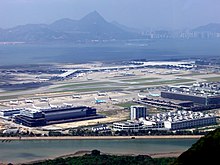
Originally the island of Lantau, west of the city center, was supposed to be removed. Because of the rich historical heritage on Lantau, it was abandoned after numerous protests. Instead, the island of Chek Lap Kok , a little north of it, was chosen as the location, which is also a popular recreational area with only a few inhabitants. The island was previously up to 100 meters high; it was removed to a height of seven meters above sea level and the excavation was dumped into the sea. A total of 1255 hectares of land was created through land reclamation . The advantage of the exposed location of the airport is its unobstructed water environment and its relatively noise-friendly suburban location with good accessibility via an expressway .
Construction work
The new airport was built from 1990 to July 1998. The work proceeded without major incidents. The construction costs totaled around 20 billion US dollars . First the island of Chek Lap Kok was demolished, then the first airport buildings and the transport corridor, each consisting of two tunnels, bridges ( Tsing Ma Bridge , Ting Kau Bridge ) and high-speed rail systems ( Airport Express ), were built. Four main parties, including the Hong Kong government, participated in the construction project. Over 200 contracts have been signed with construction companies.
completion
With the opening of the airport on Chek Lap Kok, the traffic on the old airport Kai Tak was stopped. On the morning of July 6, 1998, a Boeing 747 from Cathay Pacific Flight CX889, coming from New York , landed as the first scheduled flight with passengers at the new Hong Kong International Airport. The night before, the airport inventory, consisting of over 1200 vehicles, had been driven in a convoy from Kai Tak to the new airport. Air traffic to and from Hong Kong was thus not interrupted, but shortly afterwards the flight information display system failed , which led to delays in passenger traffic. At the Super Terminal One (ST1) air freight terminal , the system for automatically recording and processing freight failed. The staff did not manage the handling of the freight by hand, so that the freight traffic was temporarily suspended. By the end of August, all air freight had been brought to the old freight terminal at Kai Tak Airport for processing.
Development since 1998
Hong Kong Airport is becoming increasingly important for China, Asia and the world. Approximately half of the world's population can be reached within five hours of flight; For many tourists, the airport is the gateway to China.
environmental Protection
According to the airport itself, it sets new standards for environmental protection. Unnecessary aircraft noise as well as air and water pollution are avoided. In addition, over 5,400 tons of waste have been recycled in recent years . The airport participates in numerous environmental protection campaigns.
future
Forecasts predict a passenger volume of up to 100 million passengers and a cargo volume of up to nine million tons per year for Hong Kong in 2030. The master plan for 2020 envisages that the terminal will be expanded slightly to a capacity of 61 million passengers annually. In addition, X-shaped satellites with 59 parking positions are to be built in the north and south of today's terminal . In the final stage of the expansion, another terminal is to be built, which will increase the capacity from the current 45 million to 87 million. Furthermore, a system with three instead of two runways is being considered and has been expanded since 2016. To the north of the airport, another runway would be built on an area heaped up by reclamation, which then only functions as a runway. The current northern runway would then only serve as a runway, the current southern runway as a runway. Another terminal would then be built to the north. Thereafter, the airport is optionally designed for an even higher volume. The three-lane system is supported in particular by Cathay Pacific, as they want to prepare for the rapidly increasing volume and also fears that Hong Kong will fall behind other airport locations. However , this project is criticized by some environmental protection organizations - for example Greenpeace or WWF .
Terminals
Hong Kong International Airport has two terminals. It's about a three-minute walk between the two terminals. The terminals are located between the two parallel runways.
Terminal 1
Terminal 1 to the north has three floors: the arrivals hall is on level 5 and the departure hall on level 6. The airline check-in counters are located on level 7. The West Hall and East Hall on the ground floor are connected to one another by the Automated People Mover (APM). A 750 meter long railway line connects the western and eastern parts of Terminal 1 every 2 minutes.
Mainly long-haul flights are handled at Terminal 1.
Terminal 2
There are no gates in Terminal 2 of the airport. A second Automated People Mover takes passengers after check-in and security control to the APM in Terminal 1. All gates can be reached from there. The Airport Express station is located between the two terminals. You can get off at both terminals. The terminal is adjacent to the Airport World Trade Center Tower and the HKIA Tower .
There are lounges and lounges on Level 6 of Terminal 2, including Cathay Pacific , Mandarin Airlines , Air Niugini , Emirates and Singapore Airlines .
Flights to China, Asia and South Africa are handled at Terminal 2 .
Facilities and equipment
The 288 check-in counters and 80 customs offices enable fast passenger handling. The escalators and moving walkways are together over 2.5 kilometers long. There are over 120 shops and restaurants serving Asian and Western dishes in the terminals. There are also medical facilities, luggage storage, conference rooms, play areas for children, relaxation areas, prayer rooms for all religions, internet access and lounges. Almost all escalators, elevators and parking lots are handicapped accessible. There is free WiFi access throughout the airport .
Baggage handling system
The Dutch company Vanderlande is responsible for the baggage handling systems. 24 kilometers of baggage belt connect all check-in counters to the aircraft handling branches. Luggage that has been checked in at one of Hong Kong's two major train stations can also be smuggled in. The luggage is screened in a five-step security process . Up to 4,000 pieces of luggage can wait up to two days for their flight on 100 waiting lanes. In total, the system can handle almost 20,000 pieces of baggage per hour.
architecture
The construction of the airport was one of the largest architectural projects in the world at the time. The airport's architect , Norman Foster , was supported by the engineers from the structural engineering firm Ove Arup & Partner. The Y-shaped passenger terminal with its 75 piers is spanned by a roof made of curved steel shells. With a length of 1,270 meters, it is the second longest single building in the world after Terminal 3 at Beijing Airport .
Cargo facilities
DHL operates its hub for East Asia in Hong Kong. The 18,200 m² building can handle up to 440 tons of freight per day.
The Asia Airfreight Terminal has a capacity of almost 910,000 tons of freight per year. It cost around 175 million euros and is used by FedEx Express , among others .
A new freight terminal is currently being built together with Cathay Pacific and is due to open in mid-2013. It will be 246,000 m² and increase the airport's cargo capacity to 7.6 million tons per year. Around 1700 new employees will be employed there. The construction costs are estimated at around 480 million euros.
Runways
The two parallel runways run in an east-west direction. They are each 3800 meters long and 60 meters wide. Therefore, all of today's civil aircraft types, including the A380 , can land there. One of the tracks is classified in ILS category II , the other in category IIIa. The latter enables a landing with a visibility of only 200 meters.
Transport links
As a road connection, the six-lane expressway No. 8 - Route 8 - from Tsing Yi Island bundles a whole range of good feeder roads from the eastern, southern and northern areas of the metropolis. The drive near the coast is considered to be one of the most scenic routes to an airport.

The Airport Express of Hong Kong Subway - MTR - takes 25 minutes from the airport to Central .
The mostly double-decker airport buses offer a comprehensive range of connections to and from the airport.
The five-seat red taxis are numerically the largest and serve all areas within Hong Kong, excluding South Llantau and Tung Chung Road. The green taxis only serve the New Territories . The blue taxis serve all destinations within Lantau .
On SkyPier ( 海天客運碼頭 / 海天客运码头 ) combine fast ferries ( English Speedferries ) Airport among others, the cities of Macau , Shenzhen , Guangzhou (Canton) , Dongguan Humen , Zhongshan and Zhuhai .
Airlines and Destinations
Hong Kong is a hub for Cathay Pacific , DHL Aviation , Cathay Dragon , Hong Kong Airlines , Hong Kong Express Airways and Air Hong Kong . Other major airlines that fly to Hong Kong are Aeroflot , Air Asia , Air China , Air France , British Airways , China Eastern , China Southern , Delta Air Lines , El Al , Emirates , KLM , Korean Air , Lufthansa , Qantas Airways , Singapore Airlines , Turkish Airlines and United Airlines . A total of 68 airlines fly to the airport.
The most important flight destinations are Amsterdam , Denver , Detroit , Dubai , Guangzhou , Istanbul , London , Los Angeles , Moscow , New York City , Paris , Rome , Seoul , Shanghai and Tokyo . In total there are over 150 destinations (40 on mainland China) in over 50 countries. Cathay Pacific flies to 52 airports, making it the largest airline represented in Hong Kong. 36 destinations are in China. There are 19 destinations in the USA .
In German-speaking countries, Lufthansa serves Frankfurt am Main and Munich, Austrian Airlines in Vienna, Swiss and Frankfurt am Main Zurich and Cathay Pacific serve Zurich.
In the air freight business , among other things flying Aerologic , Air Hong Kong , Atlas Air , Cargolux , FedEx Express , Lufthansa Cargo , UPS Airlines and a number of other air cargo carriers.
There are almost 900 aircraft movements every day at Hong Kong Airport.
Various airlines serve Hong Kong Airport with an A380 every day, such as Qantas Airways from Sydney, Emirates from Dubai and Bangkok, Korean Air from Seoul, Singapore Airlines from Singapore, British Airways from London Heathrow, Air France from Paris and Lufthansa from Munich.
International comparison
Hong Kong Airport is a very important airport in Asia. The biggest competitor airports are the Guangzhou airport in China, the Singapore airport , the Haneda Airport and Narita Airport in Japan, the Suvarnabhumi Airport in Thailand , the Incheon Airport in South Korea and the Shanghai Pudong Airport .
The airport has partnerships with Beijing , Chicago and neighboring Shenzhen airports . For example, the websites of Hong Kong and Shenzhen airports are linked. Both airports are also linked by regular bus and ferry connections.
As part of the annual passenger survey carried out by Skytrax , Hong Kong International Airport was named the best airport in the world for the eighth time in 2011 (since 1999). In the survey, more than five and a half million passengers gave their opinion on various criteria in the area of service and facilities.
Traffic figures

| year | Passenger volume |
Air freight ( tons ) (excluding airmail ) |
Aircraft movements (excluding military) |
|---|---|---|---|
| 2019 | 71,500,000 B | 4,800,000 | 419.730 |
| 2018 | 74,672,000 | 5,121,000 | 428,000 |
| 2017 | 72,865,000 | 4,937,000 | 421,000 |
| 2016 | 70,513,000 | 4,521,000 | 412,000 |
| 2015 | 68,496,000 | 4,380,000 | 406,000 |
| 2014 | 63,343,000 | 4,376,000 | 391,000 |
| 2013 | 59,903,000 | 4,127,000 | 372,000 |
| 2012 | 56,467,000 | 4,025,000 | 352,000 |
| 2011 | 53,904,000 | 3,938,000 | 334,000 |
| 2010 | 50,923,000 | 4,126,000 | 307,000 |
| 2009 | 46,167,000 | 3,347,000 | 279,000 |
| 2008 | 48,585,000 | 3,627,000 | 301,000 |
| 2007 | 47,783,000 | 3,742,000 | 295,000 |
| 2006 | 44,443,000 | 3,580,000 | 280,000 |
| 2005 | 40,740,000 | 3,402,000 | 263,500 |
| 2004 | 37,412,000 | 3,093,900 | 237,300 |
| 2003 | 27,433,000 | 2,642,100 | 187,500 |
| 2002 | 34,313,000 | 2,478,800 | 206,700 |
| 2001 | 33,065,000 | 2,074,300 | 196,800 |
| 2000 | 33,374,000 | 2,240,600 | 181,900 |
| 1999 | 30,394,000 | 1,974,300 | 167,400 |
| 1998 | 28,631,000 A | 1,628,700 | 163.200 |
Source: Hong Kong International Airport (HKIA)
- annotation
Incidents (selection)
- On August 22, 1999, a McDonnell Douglas MD-11 of China Airlines with the flight number 642 crashed while landing at Hong Kong Airport during the approach. The machine landed hard on the runway during heavy rains and strong gusts of wind, with the right engine hitting the ground, tearing off the right main landing gear and right wing. The machine slipped off the runway, overturned, and went up in flames. Three inmates were killed.
- On July 31, 2000, an illegal immigrant with no evidence of nationality took a cleaning lady hostage with a toy gun on board a Cathay Pacific plane and demanded that she be flown to Myanmar , which is his home. A little later he surrendered to the police.
- On 30 August 2004, the approach was one of London coming Boeing 747 of the Cathay Pacific to Hong Kong airport due to a warning for wind shear canceled. The pilots set the autopilot to go around ; however, they deactivated it again unnoticed. The aircraft drifted sharply to the left towards a mountain. The pilot reacted quickly, landed the aircraft safely and was thus able to prevent a disaster. There were no injuries.
- On April 13, 2010, a Cathay Pacific Airbus A330 coming from Surabaya with flight number CX780 had to make an emergency landing here due to an engine failure. According to the airline, the right engine was switched to idle during the approach. Eight of the 309 passengers on board were injured.
- On 12 and 13 August 2019, the operation had to be temporarily stopped because the arrival and departure halls of demonstrators the protests in Hong Kong in 2019 occupied were.
Others
- The so-called SkyCity is located at Terminal 2. It houses office complexes, retail stores, hotel facilities, a bus station, an exhibition center, its own underground station, the ferry terminal and a golf course. The Hong Kong Disneyland is also in the immediate vicinity . Terminal 1 and SkyCity have a floor space of around 140,000 m². The construction costs for SkyCity were around 200 million euros.
- The automatic passenger transport system with three stations connects the terminal area with the gates and SkyCity. The trains run every 1.5 minutes at around 62 km / h. In the future, a fourth station is to be built for the ferry terminal.
See also
Web links
- Official website (Chinese, English)
- Airport data on World Aero Data ( 2006 )
- Airport data in the Aviation Safety Network (English)
- General information about the airport at travelchinaguide.com (English)
Individual evidence
- ↑ a b c d e Practical information about Hong Kong - How do I find my way around the city? - Explanation on the airport of the airline KLM ( Memento from June 29, 2015 in the Internet Archive ), accessed on April 27, 2019
- ↑ a b c d e Air Traffic Statistics. HongKongAirport.com, accessed April 14, 2019 .
- ↑ Sustainability Reports. HongKongAirport.com, accessed January 26, 2018 .
- ↑ 港 聞 - 機場 三 跑 正式 動工 - Hong Kong News - Official start of construction on the airport's third runway. Sing Tao Daily, August 2, 2016, accessed March 14, 2019 (Chinese).
- ↑ Shinya Abe: Hong Kong airport spending big on expansion - Asia's biggest hub hopes to overtake Dubai and Heathrow. Nikkei Asian Review , March 3, 2017, accessed March 14, 2019 .
- ↑ Grand Designs - Hong Kong International Airport's Third Runway. In: www.lexology.com. March 1, 2019, accessed on March 14, 2019 .
- ↑ a b The Bechtel Corporation on the construction work ( Memento from May 15, 2014 in the Internet Archive ), accessed on March 14, 2019 (English)
- ↑ Key Dates & Events . In: hongkongairport.com . Retrieved April 19, 2014.
- ↑ Mark Landler, " Problems Continue to Mount at New Hong Kong Airport, " July 9, 1998. In: The New York Times (online). Retrieved June 2, 2013.
- ↑ Hong Kong Yearbook 1998: Calendar of Events . Retrieved June 2, 2013.
- ↑ The airport company on the master plan (English, Chinese)
- ↑ aero.de: "Cathay Pacific calls for third runway"
- ^ WWF Hong Kong criticism at the airport
- ↑ a b c d e f g airport technology about the airport
- ↑ Hong Kong Airport Facilities
- ↑ Page no longer available , search in web archives: Reference of the manufacturer Vanderlande
- ↑ a b Airlines and Destinations at Hong Kong Airport
- ↑ Network News . austrian.com. Retrieved December 2, 2016.
- ↑ All destinations at a glance . swiss.com. Retrieved December 2, 2016.
- ^ The airport company on the partnership with Beijing
- ^ The airport company on the partnership with Chicago
- ^ The airport company on the partnership with Shenzhen
- ↑ Hong Kong as the best airport in the world 2011 ( memento from July 30, 2013 in the Internet Archive ), accessed on March 14, 2019
- ↑ Aircraft accident data and report of the accident of August 22, 1999 in the Aviation Safety Network (English)
- ↑ Aircraft accident data and report of the hostage-taking on July 31, 2000 in the Aviation Safety Network (English)
- ↑ thestandard.com.hk: About the hostage-taker of July 31, 2000 ( memento of October 21, 2011 in the Internet Archive ), accessed on March 14, 2019
- ↑ Aircraft accident data and report of the incident of August 30, 2004 in the Aviation Safety Network (English)
- ↑ aero.de: "Injured after an emergency landing of a Cathay Pacific Airbus A330-300"
- ↑ aero.de: "Engine defect forced Cathay Pacific flight to make an emergency landing"
- ↑ Matthias Müller, Patrick Zoll: Hong Kong: Airport blocked - the protests explained. In: nzz.ch . August 13, 2019, accessed August 13, 2019 .

